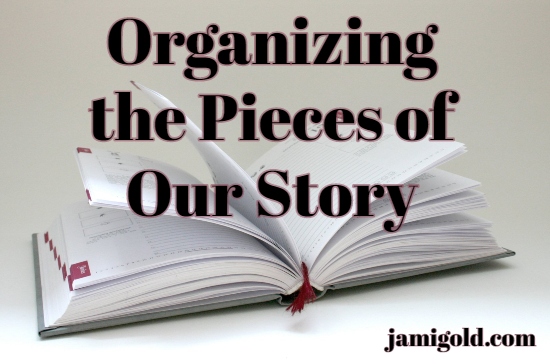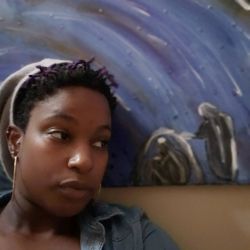Writing Process: Developing a Coherent Story — Guest: Jael R. Bakari

There’s no shortage of options for our writing process, but some will work better for us than others. Or some might work better for us on certain stories, while not being as helpful for us with other stories.
So I’m a fan of “collecting” various techniques. That way when we struggle, we’ll know about different approaches that we can try. To that end, I’ve been enjoying a Facebook conversation (in a private group, so I can’t link…sorry!), where members have been talking about their writing processes and what works for them.
The other week in this group, Constance Burris shared a video by Jael R. Bakari that talked about using Trello to ensure we’ve created a coherent story idea before we fully dive into the draft. Given that we recently talked about our organizational methods (including Trello), I wanted to dig more into the ideas Jael explored in her video, and luckily she was gracious enough to visit and explain her process.
In this post, she’s not only sharing her video, but she’s explaining the what’s and the why’s of each step of her writing process. As a bonus, her process could be used by plotters in advance of drafting, or by pantsers (those who write by the seat of their pants) in preparation for their revision stage, or by anyone tackling their story in between those methods.
Please welcome Jael R. Bakari! *smile*
*****
Developing a Coherent Story:
Breaking Down the Process
By Jael R. Bakari
If you are anything like me (and I’m sure you are because you’re reading this), then you probably have done multiple revisions of stories, chapters, and scenes because you knew something was missing (or you kept getting rejected by agents—or ghosted), and you want to see exactly what the problem is. And being a creative, the natural response is to wallow with dramatic flair, before dusting yourself off to try again.
That, dear reader, is how this writing process was born.
For I, too, trek on the road to being published with thee and was honestly getting tired of having my ass handed to me.
But first—where did the idea for the process come from?
Discovering the Writing Process
Welp, funny enough, I stumbled upon this article series, and after months of struggling with my process, I finally saw what was wrong. Agents were expecting a polished story, not a perfect one. And polishing didn’t have so much to do with the prose, but rather elements of the story and how I wove them together.
As I read through the post and re-watched Ever After (seriously, do it) to see what a cohesive story looked like and how many fine details had to match up, I remember instantly panicking and thinking that’s a lot to keep track of. And a light bulb clicked.
I live in the 21st century, and I have project management and production experience. Why don’t I use my experience from there, along with everything that I learned so far on my journey, and come up with a simpler way to get my drafts written and edited without banging my head into a wall because I can’t find prose purple enough to describe a sunset.
Video: My Writing Process
Here’s the video that shows you the pieces in action, and I’ll break down the pieces of my assembly line below.
YouTube video: My Writing Process
8 Steps of Story Development
The production line of revision…
#1: The Pitch and the Premise
If you can’t break your idea down inside of a few words, you don’t have a story. You have a collection of really cool but random events and ideas. Humans need a story to impart meaning onto those really cool ideas, and story comes from four core ideas.
I got this from the fabulous author Ms. Bethany Baptiste (follow her on twitter @StorySorcery), and how she breaks it down is simple. Every story has:
- a world premise
- a character
- an obstacle for the character
- the stakes for what happens if the character doesn’t face that big bad obstacle
So before you commit hours to revising that manuscript, make sure you can answer the following basic questions:
- How would you describe the world of your character?
Example: In Game of Thrones, we have a kingdom in a state of flux. - How would you describe your character?
Example: A family is ill prepared for the intrigue of court. - What are the obstacles?
Example: politics of the realm - What are the stakes?
Example: They have to adapt to the realm or risk their lives.
Once you can answer these questions in a way that makes you say “Oh, that’s interesting,” you can come up with a 250-300 word summary of what’s happening. Don’t think details so much here as zooming out to see what the reader would say this story is about if they were to explain it haphazardly. You want to nail this summary because this is what you are going to use to sell your story once the last word is typed.
Check out Bethany’s presentation Polish Your Pitch, B*tch for a more in-depth look at how to do this step. (Note from Jami: Obviously, language at that link, but Jael’s right that it’s a great pitching resource!)
#2: Genre, Tropes, and Conventions, Oh My!
Once you know the basic idea behind your story, next you want to move on to breaking it into both genre and sub-genre. And I don’t just mean Fantasy or Literary Fiction. I mean the genre story shape.
What genre milestones does our story need? @jaelrbakari shares how it's more complex than we think Click To TweetThis concept comes from Shawn Coyne’s brilliant book The Story Grid. After publishing for over two decades, he expertly breaks down all the stories he’s seen come across his desk as an editor into a few neat genres. And those genres have certain expectations to be met.
Why is this important?
Because it’ll tell you what you need to play up, subvert, or include inside the story to give your readers a high-level user-friendly experience. In other words, you gotta know the rules and your story so you can know how and when to break the rules. The Story Grid website has some great breakdowns to help point you in the right direction, as well as an excellent overview of what genre is.
#3: Story Math
Look I get it. You are a creative and you don’t want shackles on the brilliant mind of yours. You want to be free and soar above the clouds of happy words and side trips along fields of flowers.
How do we shape our ideas into a coherent story? @jaelrbakari shares her process Click To TweetBut your readers have only so much attention span. The size of it is largely determined by the market genre (e.g. Literary, Fantasy, Sci-Fi).
You’re not going to write 150k words for a Middle Grade book intended for kids, nor will you write a 30,000 word Adult Fantasy and try to sell it in the same market as A Song of Ice and Fire. You need to write a comfortable length book for your market that the genre’s readers are used to handling.
To do that, you need to have check points in your story. The check points I use are a combination of The Story Grid Math and Save the Cat Writes a Novel.
Each of the acts in every published book is usually broken up in about the same shape: Act 1 25%, Act 2 50%, and Act 3 25%. Inside each of those acts, certain milestones are expected to take place at certain points in the manuscript, or the story begins to drag and turn back into those really cool but random events and ideas.
Knowing approximately how many words you need to hit can keep you from:
- over or underwriting a scene or
- potentially missing a key reader reaction meant to further immerse them into the story.
#4: Obligatory Scenes and Story Events
These scenes and events are the absolute must have’s for the story. Without them, the story will fall as flat as your book to the floor from the reader’s hand.
Genre is largely going to determine what these scenes and events are, so make sure you know your genre very well. Once you know your obligatory scenes, you must also know what your major story events are going to be so you can stay on target as you write.
#5: Characters, Aesthetic, and Settings
The aesthetic of your book is what’s going to determine the word choices and how you choose to play out the characters. Same with the settings you choose.
You want to keep track of character descriptions, locations, and setting so you can keep track of what’s happening in your story as it happens. The worst thing you can do is insert something inconsistent in your story and allow it to disrupt the flow of the fictive dream.
Movie and stage productions do this to keep track of everything and keep it running seamlessly. Your book is essentially a movie, direct it as such.
#6: Free-Writing
This step is key for playing around with where you feel the story should start. Starting the story as close to the action as possible is key for getting a story to land.
Like, imagine if Avatar the Last Airbender had started with when Sokka and Katara’s dad left rather than when they found Aang. It would have been a snooze fest.
Free writing can help you find out what feels natural to the story you are telling. When I free-write, I just keep in mind the “but therefore” rule expressed by Trey Parker and Matt Stone which goes like: A character wants something, but something gets in their way, so they’re forced to take an action, and therefore something new happens. And the scenes continue on in length according to this cause-and-effect formula.
Note: I try to keep my scenes around 1500 words in length because those are potato chip length and give readers a nice place to pause if they need to put the book down for a second.
#7: Outline
After I free write, I create an outline so I can keep track of what’s happening in the story. The outline is simple.
I want to know:
- the setting and time
- the choice the character made in the scene
- any major events that took place
- any key details I need to thread into the scene
For example, I want my first and final image of the character to line up, so I gotta make sure they mirror each other but in different ways. That way when the book is reread, the audience can see that the clues for where the story would end were there all along.
#8: Timeline of Events
This goes back to what I said about keep tracking of what’s going on in your story. Your details need to remain consistent throughout.
Remember that a story is essentially a giant lie. And the bigger the lie, the greater the detail needed. Keeping those timelines in order keeps you on track and not putting sunsets where sunrises are supposed to be happening.
Final Thoughts
With all those details categorized and at your disposal, you can chisel away at that rough first draft and hone your story into a piece of art that can allow your writing to do what it does best: Sing the story to your beloved reader. Now if you’ll excuse me, I gotta go finish chiseling out my own manuscript.
Happy Sculpting!
*****
About Jael R. Bakari

Jael is a weirdo. Armed with an imagination that rivals virtual reality and a M.S. in Psych, when Jael isn’t analyzing the actions of celebrities and public figures, she is busy creating rich worlds of Color (pun intended) dressed in fantasy and magic that focus on her life’s mission: to show we are all human through the power of stories.
Her hobbies include reminiscing about growing up in pre-Hipster Brooklyn, reading all the books, and painting, with the bulk of her time split between raising an active family of five with her husband, Solomon, in the Peach State and sprinkling the outcomes of her research, meditations, musings, and general silliness across social media.
*****
About Jael R. Bakari’s Work:
I write frequently on my blog, jaelrbakari.com, where I explore everything from the struggle of querying and lessons I picked up along the way, to my ruminations on the current state of world affairs.
I also use it to hone my short story writing, so you can watch me anguish through the process of craft improvement as well.
To learn more about Jael and read the weird thoughts from her head, visit her at her website or on social media:
Website | Medium | Instagram | Facebook | YouTube | Twitter
*****
Thank you, Jael! When I first saw your video, I loved how you brought all the elements of story development together into a single organized Trello board. This breakdown does an even better job of explaining all the ideas and concepts that went into your organization. Love it! *smile*
As Jael mentions in her video, developing a coherent story requires a lot of moving parts, and just like a TV, movie, or stage production, we need to keep track of a ton of details. Many of the tools I share (and have created), such as various beat sheets and worksheets, are meant to give us a big-picture view (like those checkpoints and milestones she talked about) of our story so we can see what’s working and what’s not. Jael’s system takes that big-picture view and turns it into a whole writing process that we can use before drafting, before revising, or throughout our story’s development.
Personally, I loved the insight in her video into how—regardless of our genre—our story can include the shapes of other genres or types of stories, and thus our story might need to have obligatory scenes/events from multiple genres. For example, I’ve read historical romance stories that are also a murder mystery or a spy adventure. Similarly, some paranormal romance stories are shaped more by fantasy, and others are shaped more by horror or science fiction or thriller, etc.
This understanding can help us figure out how to fill the scenes of our story, especially when the stereotypical story-shape of our genre doesn’t seem to quite fit. Instead, our story might need to mesh multiple genre structures together, which is great for making our story unique. *smile*
Do you have a specific writing process? How does it compare to this one? Do you think Jael’s process might help you create a more coherent story? Or can you take elements of Jael’s process to make your drafting, revision, and production more effective? Do you have any questions for Jael?
Pin It

Thank you so much Jami for sharing thi!!
Hi Jael,
Thank you for sharing your process and insights! I know I came away with a greater understanding for how to get a handle on my story, so I’m sure it will help others as well. 😀
Excellent advice and resources for beginners or old pros who need to revitalize.
Hi Mike,
Exactly! I’ve been at this writing thing long enough that it’s hard to teach me something new, but I came away with several new understandings from Jael’s insights and resources that might help me in my writing — and I’m super-glad I’m not alone in that. Love it! 😀
I love this. I found the video a few weeks ago, and it totally recharged my current WIP revisions. This breakdown is the icing on the cake.
Hi Constance,
And thank you for sharing that video! I hope your great experience with trying this process out is a harbinger of others’ success with it as well. 😀
Thanks for sharing this — it’s a terrific approach to moving through the story development process without getting sidetracked (too much) at any stage. If you know what the next step is, it’s easier to get to where you’re going! Great info, as always!
[…] Writing Process: Developing a Coherent Story by Jael R. Bakari via Jami Gold […]